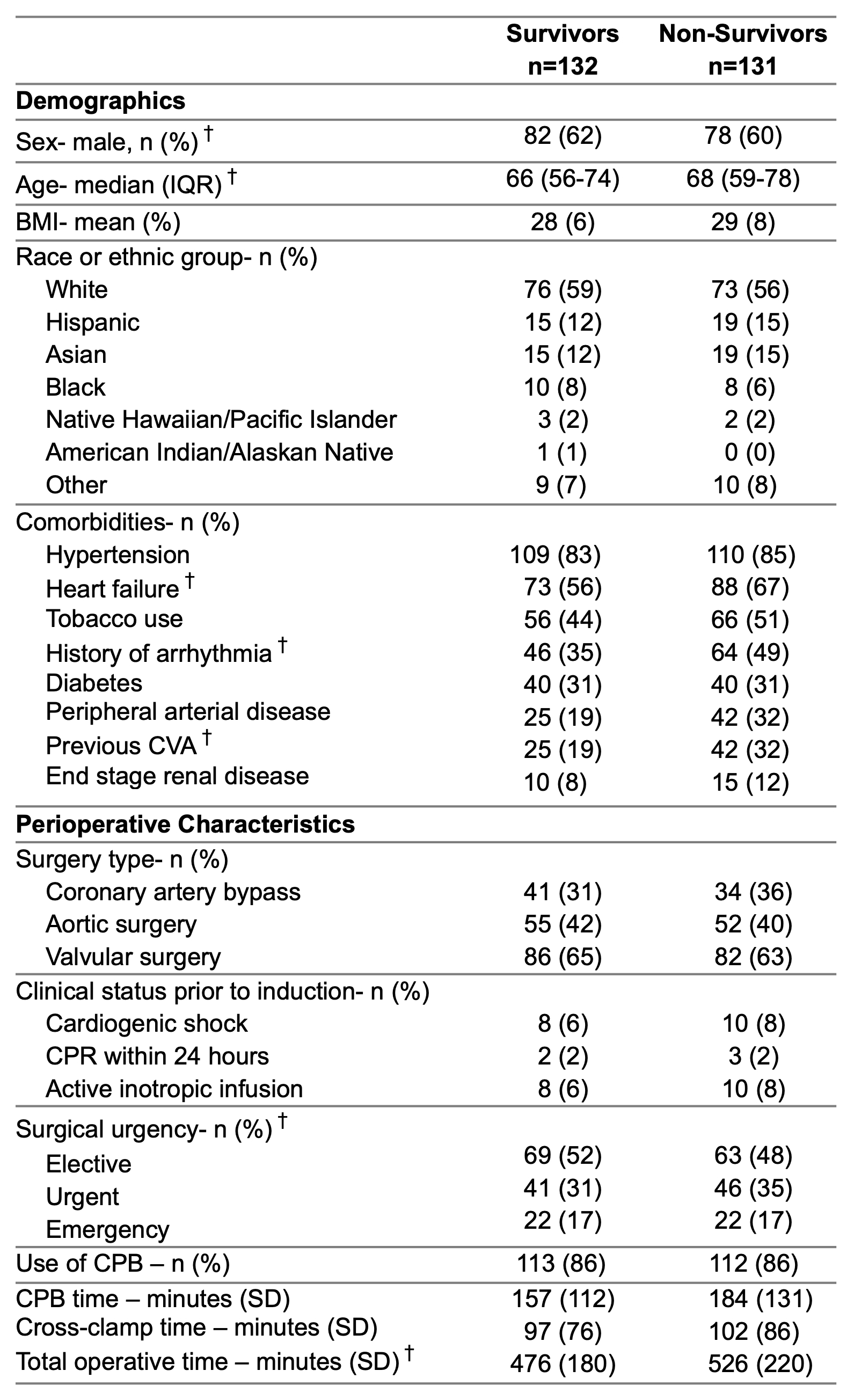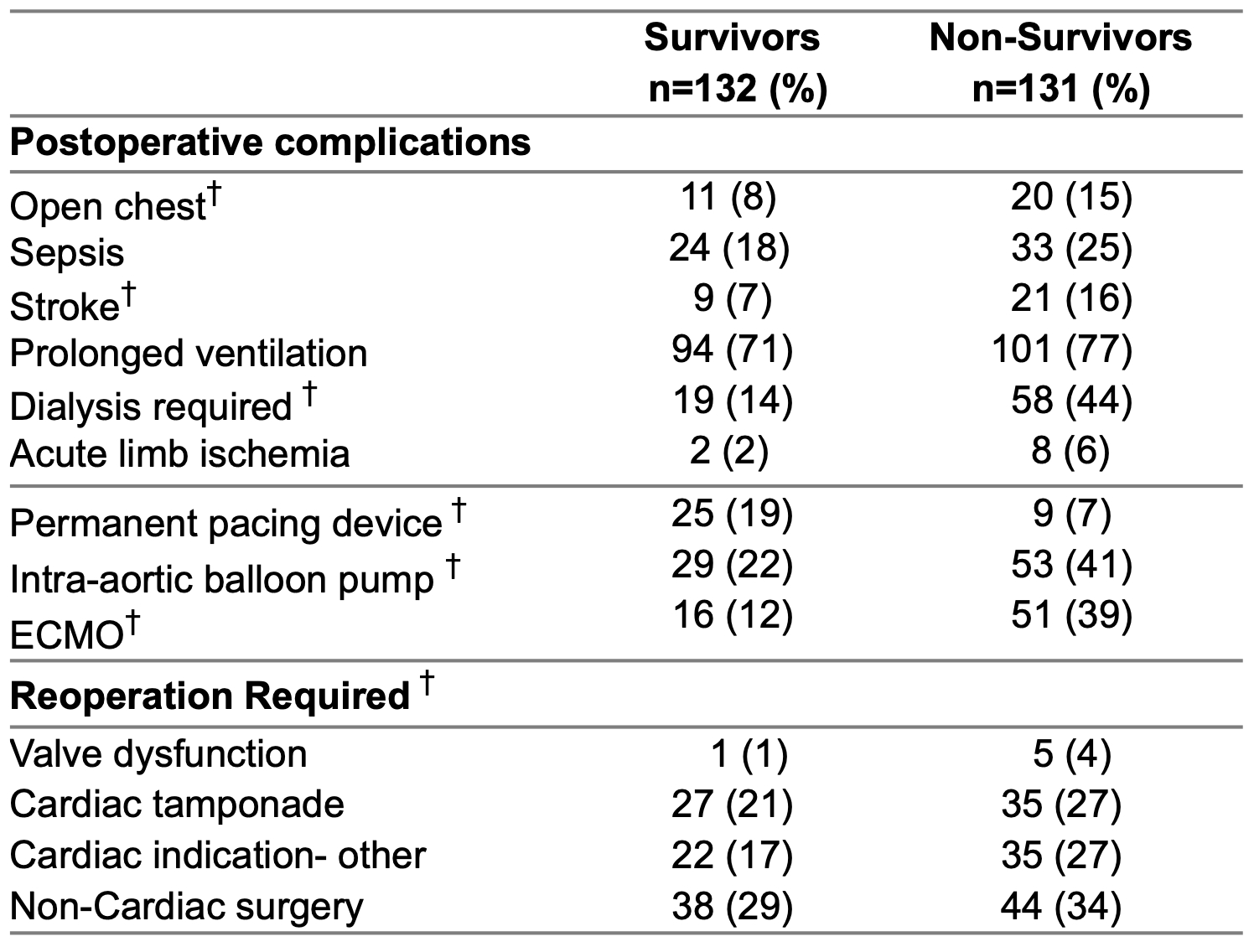Final ID: Sa901
In-Hospital Cardiac Arrest After Cardiac Surgery: Incidence, Prognostic Features, and Outcomes at a Single Institution From 2011-2024
Abstract Body: Introduction: In the United States, the incidence of in-hospital cardiac arrest (IHCA) ranges from 0.1-0.5% and most larger studies report about 20% of patients survive to hospital discharge. IHCA after cardiac surgery is unique because patients are often monitored closely and arrest etiologies are frequently reversible. This may contribute to improved survival, however current data on cardiac arrest outcomes that reflect the rapidly evolving landscape of cardiac surgery and intensive care are lacking.
Aims: To identify the incidence, prognostic features, and outcomes of cardiac arrest following cardiac surgery at a single high-volume academic center.
Methods: We identified all adult (≥18 years) patients who underwent cardiac surgery and experienced in-hospital cardiac arrest at our institution from 2011-2024 in our local Society of Thoracic Surgery database. The primary outcome was the incidence of cardiac arrest after cardiac surgery. In an exploratory analysis, we fit a multivariable logistic regression for death before discharge, adjusting for variables noted in Tables 1 and 2. All analyses were performed in R (Version 2024.04.1+748). A p value < .05 was considered significant. No adjustment for the family-wise error rate was made – all analyses should be considered hypothesis-generating.
Results: Of 10,152 surgeries, 263 cases (2.6%) of postoperative cardiac arrest were identified. Survival to discharge occurred in 123 (50%) of cases. Median age was 67 (IQR 57-75) and 103 (39%) patients were female (Table 1). In adjusted analyses, death before discharge was significantly associated with use of extracorporeal membrane oxygenation (OR 3.52, CI 1.51-8.23, p=0.003), postoperative dialysis (OR 3.27, CI 1.57-6.77, p=0.001), pre-operative stroke (OR 2.28, CI 1.17-4.46, p=0.016), post-operative stroke (OR 3.01, CI 1.04-8.73, p=0.042), and age (OR 1.03, CI 1.01-1.05, p=0.016) (Figure 1). Survival to discharge was associated with placement of permanent pacing device (OR 0.30, CI 0.11-0.81, p=0.017).
Conclusions: Incidence of IHCA after cardiac surgery is much higher than in the general inpatient population. However, survival to discharge is also common, suggesting that cardiac surgical patients have distinctly different outcomes after IHCA compared to other inpatient populations. In an exploratory analysis, we identified several factors associated with survival to hospital discharge after cardiac arrest which can be examined in future studies.
Aims: To identify the incidence, prognostic features, and outcomes of cardiac arrest following cardiac surgery at a single high-volume academic center.
Methods: We identified all adult (≥18 years) patients who underwent cardiac surgery and experienced in-hospital cardiac arrest at our institution from 2011-2024 in our local Society of Thoracic Surgery database. The primary outcome was the incidence of cardiac arrest after cardiac surgery. In an exploratory analysis, we fit a multivariable logistic regression for death before discharge, adjusting for variables noted in Tables 1 and 2. All analyses were performed in R (Version 2024.04.1+748). A p value < .05 was considered significant. No adjustment for the family-wise error rate was made – all analyses should be considered hypothesis-generating.
Results: Of 10,152 surgeries, 263 cases (2.6%) of postoperative cardiac arrest were identified. Survival to discharge occurred in 123 (50%) of cases. Median age was 67 (IQR 57-75) and 103 (39%) patients were female (Table 1). In adjusted analyses, death before discharge was significantly associated with use of extracorporeal membrane oxygenation (OR 3.52, CI 1.51-8.23, p=0.003), postoperative dialysis (OR 3.27, CI 1.57-6.77, p=0.001), pre-operative stroke (OR 2.28, CI 1.17-4.46, p=0.016), post-operative stroke (OR 3.01, CI 1.04-8.73, p=0.042), and age (OR 1.03, CI 1.01-1.05, p=0.016) (Figure 1). Survival to discharge was associated with placement of permanent pacing device (OR 0.30, CI 0.11-0.81, p=0.017).
Conclusions: Incidence of IHCA after cardiac surgery is much higher than in the general inpatient population. However, survival to discharge is also common, suggesting that cardiac surgical patients have distinctly different outcomes after IHCA compared to other inpatient populations. In an exploratory analysis, we identified several factors associated with survival to hospital discharge after cardiac arrest which can be examined in future studies.
More abstracts on this topic:
A Novel Method to Assess the Brain Functional Condition through Visualization of its Emitted Infrared Waves.
Ghevondyan Tigran
A Comparison of Synchronized Versus Unsynchronized Mechanical Chest Compressions in a Swine ModelMarill Keith, Menegazzi James, Gumucio Jorge, Salcido David



